

A helmet is a form of protective gear worn to protect the head. More specifically, a helmet complements the skull in protecting the human brain. Ceremonial or symbolic helmets (e.g., a policeman's helmet in the United Kingdom) without protective function are sometimes worn. Soldiers wear combat helmets, often made from Kevlar or other lightweight synthetic fibers.
The word helmet is derived from helm, an Old English word for a protective head covering.
Helmets are used for most sports (e.g., jockeys, American football, ice hockey, cricket, baseball, skiing, hurling and rock climbing); dangerous work activities such as construction, mining, riot police, military aviation, and in transportation (e.g. motorcycle helmets and bicycle helmets). Since the 1990s, most helmets are made from resin or plastic, which may be reinforced with fibers such as aramids.
Designs
Some British gamekeepers during the 18th and 19th centuries wore helmets made of straw bound together with cut bramble. Europeans in the tropics often wore the pith helmet, developed in the mid-19th century and made of pith or cork.
Military applications in the 19th–20th centuries saw a number of leather helmets, particularly among aviators and tank crews in the early 20th century. In the early days of the automobile, some motorists also adopted this style of headgear, and early football helmets were also made of leather. In World War II, American, Soviet, German, Italian and French flight crews wore leather helmets, the German pilots disguising theirs under a beret before disposing of both and switching to cloth caps. The era of the First and Second World Wars also saw a resurgence of metal military helmets, most notably the Brodie helmet and the Stahlhelm.
Modern helmets have a much wider range of applications, including helmets adapted to the specific needs of many athletic pursuits and work environments, and these helmets very often incorporate plastics and other synthetic materials for their light weight and shock absorption capabilities. Some types of synthetic fibers used to make helmets in the 21st century include aramid fibers, such as Kevlar and Twaron. Race car helmets include a head and neck support system that keeps the helmet (and head) attached to the body in severe collisions.
Helmet types

Helmets of many different types have developed over time. Most early helmets had military uses, though some may have had more ceremonial than combat applications.
Two important helmet types to develop in antiquity were the Corinthian helmet and the Roman galea.
During the Middle Ages, many different military helmets and some ceremonial helmets were developed, almost all being metal. Some of the more important medieval developments included the great helm, the bascinet, the frog-mouth helm, and the armet.
The great seal of Owain Glyndŵr (c. 1359 – c. 1415) depicts the prince of Wales & his stallion wearing full armour, they both wear protective headgear with Owain's gold dragon mounted on top. This would have been impractical in battle, so therefore these would have been ceremonial.
In the 19th century, more materials were incorporated, namely leather, felt and pith. The pith helmet and the leather pickelhaube were important 19th century developments. The greatest expansion in the variety of forms and composition of helmets, however, took place in the 20th century, with the development of highly specialized helmets for a multitude of athletic and professional applications, as well as the advent of modern plastics. During World War I, the French army developed the Adrian helmet, the British developed the Brodie helmet, and the Germans produced the Stahlhelm.

The development of hard hats for workplace safety may have been inspired by the helmets of WWI, and they have become a standard type of safety equipment on many construction job sites and industrial locations.
Flight helmets were also developed throughout the 20th century. A multitude of athletic helmets, including football helmets, batting helmets, hockey helmets, cricket helmets, bicycle helmets, ski helmets, motorcycle helmets and racing helmets, were also developed in the 20th century.
Helmets since the mid-20th century have often incorporated lightweight plastics and other synthetic materials, and their use has become highly specialized. Some important recent developments include the French SPECTRA helmet, Spanish MARTE helmet or the American PASGT (commonly called "Kevlar" by U.S. troops) and Advanced Combat Helmet, or ACH.
Heraldry
Main article: Helmet (heraldry)| Part of a series on |
| Heraldic achievement |
|---|
| External devices in addition to the central coat of arms |
Escutcheon
Field
Supporter
Crest
Torse
Mantling
Helmet
Crown
Compartment
Charge
Motto (or slogan)
Coat of arms

|
|
|
As the coat of arms was originally designed to distinguish noble combatants on the battlefield or in a tournament, even while covered in armour, it is not surprising that heraldic elements constantly incorporated the shield and the helmet, these often being the most visible parts of a knight's military equipment.
The practice of indicating peerage through the display of barred or grilled helmets first appeared around 1587-1615, and the heraldic convention of displaying helmets of rank in the United Kingdom, which came into vogue around Stuart times, is as follows:
- Sovereign: a gold barred-face (tournament) helm placed affronté
- Peer's helmet: silver barred-face (tournament) helm placed in profile
- Knight's or baronet's helmet: steel helm (earlier jousting helm, later close helm) placed affronté with visor open
- Esquire's helmet: steel helm placed in profile with visor closed
Earlier rolls of arms reveal, however, that early heraldic helmets were depicted in a manner faithful to the styles in actual military or tournament use at the time.
Gallery
-
 Boar tusk Minoan helmet, 1600–1500 BCE
Boar tusk Minoan helmet, 1600–1500 BCE
-
 Boar tusk Mycenaean helmet, 14th century BCE
Boar tusk Mycenaean helmet, 14th century BCE
-
 Corinthian helmet with detachable horns, circa 650 BCE
Corinthian helmet with detachable horns, circa 650 BCE
-
 Corinthian helmet, 500 BCE
Corinthian helmet, 500 BCE
-
 Greek Chalcidian helmet, 500 BCE
Greek Chalcidian helmet, 500 BCE
-
 Greek pilos helmet, 450–425 BCE
Greek pilos helmet, 450–425 BCE
-
 Boeotian helmet, 4th century BCE
Boeotian helmet, 4th century BCE
-
 Greek Illyrian type helmet, 4th century BCE
Greek Illyrian type helmet, 4th century BCE
-
 Thracian helmet, 4th century BCE
Thracian helmet, 4th century BCE
-
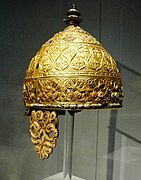 Celtic (Gallic) parade helmet, 350 BCE
Celtic (Gallic) parade helmet, 350 BCE
-
 Attic helmet, 350 BCE to 300 BCE
Attic helmet, 350 BCE to 300 BCE
-
 Greek bronze Phrygian helmet, 350 BCE to 300 BCE
Greek bronze Phrygian helmet, 350 BCE to 300 BCE
-
 Roman cavalry helmet, 1st century CE
Roman cavalry helmet, 1st century CE
-
 Roman cavalry helmet
Roman cavalry helmet
-
Black Mongolian helmet
-
 Iranian, 7th or 8th century CE Spangenhelm
Iranian, 7th or 8th century CE Spangenhelm
-
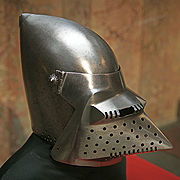 Early 15th century bascinet with hounskull visor
Early 15th century bascinet with hounskull visor
-
 15th-century German frog-mouth helm used in jousting
15th-century German frog-mouth helm used in jousting
-
 Ottoman zischagge helmet, mid-16th century
Ottoman zischagge helmet, mid-16th century
-
 16th century Maximilian style close helmet
16th century Maximilian style close helmet
-
 19th-century Japanese kabuto
19th-century Japanese kabuto
-
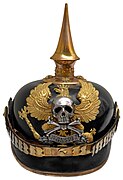 German Pickelhaube
German Pickelhaube
-
 Late 19th-century pith helmet
Late 19th-century pith helmet
-
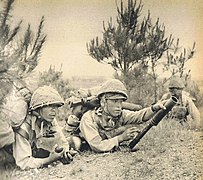 Type 90 helmets worn by the Japanese during the Second World War
Type 90 helmets worn by the Japanese during the Second World War
-
 A German stahlhelm during World War II
A German stahlhelm during World War II
-
Vietnam War era Marine squadron VMA-311 flight helmet
-
 PASGT helmet
PASGT helmet
-
 Leather and steel firefighting helmet
Leather and steel firefighting helmet
-
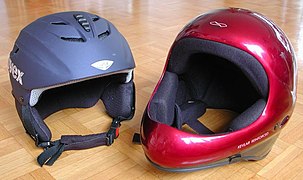 Ski helmet (left), paragliding helmet (right)
Ski helmet (left), paragliding helmet (right)
-
 Astronaut helmet
Astronaut helmet
-
 Aviakit motorcyclist "pudding basin" helmet
Aviakit motorcyclist "pudding basin" helmet
-
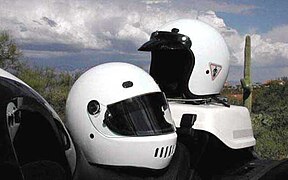 Full face and open face motorcycle helmets
Full face and open face motorcycle helmets
-
 Hurling/Camogie helmet
Hurling/Camogie helmet
-
 Magnus Muhrén wearing a bandy helmet
Magnus Muhrén wearing a bandy helmet
See also
References
- "helmet (n.)". etymonline.com.
- Hopkins, Harry (1985). The Long Affray. London: Secker & Warburg. ISBN 0-436-20102-X.
- "The Pith Helmet | Perspectives on History | AHA". Historians.org.
- "Why were WWII helmet designs so different by country & which design was the most effective?". War History Online. 5 January 2019.
- "Materials of Motorcycle Helmets".
- Lance, Rachel (6 December 2020). "A Race Car Crash from Hell—and the Science That Saved Its Driver". Wired. Retrieved 7 December 2020.
- "Great Seal of Owain Glyndŵr", Guto's Wales
- Fox-Davies, Arthur Charles; Johnston, Graham (2004) . A Complete Guide to Heraldry. Whitefish, MT: Kessinger Publishing. ISBN 1-4179-0630-8. P. 319.
- Fox-Davies, P. 303.
- Fox-Davies, P. 316.
External links
- "Helmets...A Medieval Note In Modern Warfare", August 1942, Popular Science evolution of military helmets
| Clothing | |||||||||
|---|---|---|---|---|---|---|---|---|---|
| Headwear | |||||||||
| Neckwear | |||||||||
| Underwear and lingerie |
| ||||||||
| Tops | |||||||||
| Bottoms |
| ||||||||
| Full-Body Wear |
| ||||||||
| Coats and outerwear |
| ||||||||
| Nightwear | |||||||||
| Swimwear | |||||||||
| Legwear | |||||||||
| Footwear | |||||||||
| Accessories |
| ||||||||
| Dress codes |
| ||||||||
| Related | |||||||||
| Helmets | |||||||||||||||
|---|---|---|---|---|---|---|---|---|---|---|---|---|---|---|---|
| Individual historical helmets |
| ||||||||||||||
| Combat |
| ||||||||||||||
| Athletic | |||||||||||||||
| Work | |||||||||||||||
| Other | |||||||||||||||
| Headwear | |||||||||
|---|---|---|---|---|---|---|---|---|---|
| |||||||||
| Helmets |
| ||||||||
| Other protective | |||||||||
| Hairwear and other items | |||||||||
| Eyewear | |||||||||
| List of headwear | |||||||||